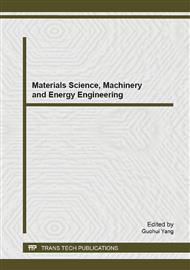[1]
Z. Szeliga, D. Juchelkova, B. Cech, P. Kolat, F. Winter, A.J. Campen and T.S. Wiltowski: Potential of alternative sorbents for desulphurization: From laboratory tests to the full-scale combustion unit. Energy Fuels, Vol. 22 (2008), pp.3080-3088.
DOI: 10.1021/ef800218t
Google Scholar
[2]
T. Reed and S. Gaur: An Atlas of Thermal Data for Biomass and Other Fuels, Biomass Energy Foundation Press, Franktown, CO (2009), p.259.
Google Scholar
[3]
H. Raclavska, D. Juchelkova, H. Skrobankova, J. Wiltowski and A. Campen: Conditions for energy generation as an alternative approach to compost utilization. Environ. Technol., Vol. 32 (2011), pp.407-417.
DOI: 10.1080/09593330.2010.501089
Google Scholar
[4]
P. Rekha, D.S.S. Raj, C. Aparna, V.H. Bindu and Y. Anjaneyulu: Bioremediation of Contaminated Lake Sediments and Evaluation of Maturity Indicies as Indicators of Compost Stability. Int. J. Environ. Res. Public Health, Vol. 2 (2005), pp.251-262.
DOI: 10.3390/ijerph2005020008
Google Scholar
[5]
M. Cox, H. Nugteren and M. Janssen-Jurkovicova: Combustion Residue – Current, Novel and Renewable Applications, John Wiley & Sons Ltd, Chichester, England (2008), p.442.
Google Scholar
[6]
A. Lucassen, N. Labbe, P.R. Westmoreland and K. Kohse-Höinghaus: Combustion chemistry and fuel-nitrogen conversion in a laminar premixed flame of morpholine as a model biofuel. Combust. Flame, Vol. 158 (2011), pp.1647-1666.
DOI: 10.1016/j.combustflame.2011.02.010
Google Scholar
[7]
P. Sykorova, D. Juchelkova, M. Kucerova and K. Raclavsky: The possibilities of influencing the content of nitrogen in composts utilized for energy production. Inzynieria Mineralna, Vol. 28 (2012), pp.69-79.
Google Scholar
[8]
G. Stubenberger, R. Scharler, S. Zahirović and I. Obernberger: Experimental investigation of nitrogen species release from different solid biomass fuels as a basis for release models. Fuel, Vol. 87 (2008), pp.793-806.
DOI: 10.1016/j.fuel.2007.05.034
Google Scholar
[9]
M. Balat, M. Balat, E. Kirtay and H. Balat: Main routes for the thermo-conversion of biomass into fuels and chemicals. Part 1: Pyrolysis systems. Energy Conv. Manag., Vol. 50 (2009), pp.3147-3157.
DOI: 10.1016/j.enconman.2009.08.014
Google Scholar
[10]
H.K. Weber: Separation of chemicals as co-products in pulp and fibre processing. Workshop Biorefinery, Austrian Activities and IEA Bioenergy, Task 42, Vienna (2007).
Google Scholar
[11]
C. -L. Hsi and J. -T. Kuo: Estimation of fuel burning rate and heating value with highly variable properties for optimum combustion control. Biomass Bioenerg., Vol. 32 (2008), pp.1255-1262.
DOI: 10.1016/j.biombioe.2008.03.008
Google Scholar
[12]
A.J. Baker: Wood fuel properties and fuel products from woods. Fuelwood Management and Utilization Seminar: Proceedings, Michigan State University, East Lansing, MI (1983), pp.14-25.
Google Scholar
[13]
P. Teixeira, H. Lopes, I. Gulyurtlu, N. Lapa and P. Abelha: Evaluation of slagging and fouling tendency during biomass co-firing with coal in a fluidized bed. Biomass Bioenerg., Vol. 39 (2012), pp.192-203.
DOI: 10.1016/j.biombioe.2012.01.010
Google Scholar
[14]
A.A. Khan, W. de Long, P.J. Jansens and H. Spliethoff: Biomass combustion in fluidized bed boilers: Potential problems and remedies. Fuel Process. Technol., Vol. 90 (2009), pp.21-50.
DOI: 10.1016/j.fuproc.2008.07.012
Google Scholar
[15]
D. Vamvuka and E. Kakaras: Ash properties and environmental impact of various biomass and coal fuels and their blends. Fuel Process. Technol., Vol. 92 (2011), pp.570-581.
DOI: 10.1016/j.fuproc.2010.11.013
Google Scholar
[16]
H. Raclavska, D. Juchelkova, V. Roubicek and D. Matysek: Energy utilisation of biowaste – Sunflower-seed hulls for co-firing with coal. Fuel Process. Technol., Vol. 92 (2011), pp.13-20.
DOI: 10.1016/j.fuproc.2010.03.006
Google Scholar
[17]
N. Kaliyan and V.R. Morey: Factors affecting strength and durability of densified biomass products. Biomass Bioenerg., Vol. 33 (2009), pp.337-359.
DOI: 10.1016/j.biombioe.2008.08.005
Google Scholar


